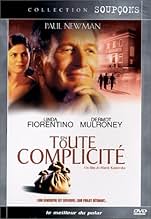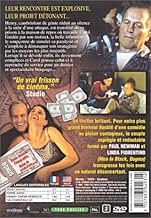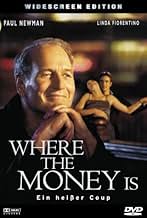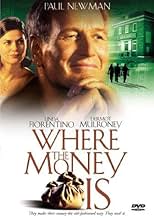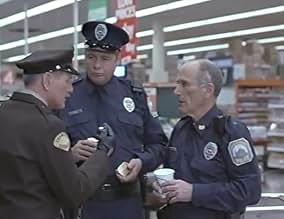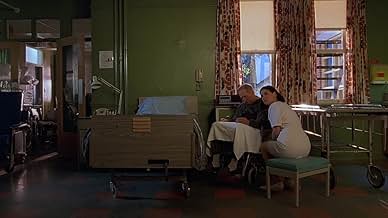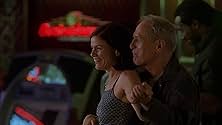PUNTUACIÓN EN IMDb
6,3/10
6,6 mil
TU PUNTUACIÓN
El viejo ladrón de bancos Henry, paralizado por derrame cerebral, es trasladado del hospital de la cárcel a una residencia de ancianos, donde Carol es enfermera. Ella no cree que esté parali... Leer todoEl viejo ladrón de bancos Henry, paralizado por derrame cerebral, es trasladado del hospital de la cárcel a una residencia de ancianos, donde Carol es enfermera. Ella no cree que esté paralizado y lo ve como una salida a su aburrida vida.El viejo ladrón de bancos Henry, paralizado por derrame cerebral, es trasladado del hospital de la cárcel a una residencia de ancianos, donde Carol es enfermera. Ella no cree que esté paralizado y lo ve como una salida a su aburrida vida.
Irma St. Paule
- Mrs. Galer
- (as Irma St. Paul)
Rita Tuckett
- Mrs. Weiler
- (as Rita Tucket)
Rod McLachlan
- Lloyd the Cop
- (as Roderick McLachlan)
Argumento
¿Sabías que...?
- CuriosidadesPaul Newman's final starring role in a film. His remaining film work would be in supporting roles and voice-overs.
- PifiasWhile the talk is about toaster ovens, the bank offers toasters only - the billboards clearly show a toaster and the description is 'toaster', not 'toaster oven'.
- Citas
Henry Manning: Honey, I'm playing brain dead, not brain damaged.
- ConexionesReferenced in Eisai to tairi mou!: Episodio #1.1 (2001)
- Banda sonoraYou Might Think
Performed by The Cars
Written by Ric Ocasek
Courtesy of Elektra Entertainment Group
By Arrangement with Warner Special Products
Reseña destacada
For admirers of quality movies, one of the greatest sources of frustration has always been the inverse ration that exists between movies that are good and movies that make money. The essential rule of thumb is that, with few exceptions, the larger a film's budget happens to be, the less likely that that film will have anything new or original to say. The corollary principle is that, given the choice between patronizing a film that is original, complex and meaningful and one that is derivative, simpleminded and thematically empty, the mass audience will go with the latter type every time. Driven by the need for profits, large studios are then forced to cater to this `lowest common denominator' mentality. The result is that wonderful little films are almost invariably squeezed out of the marketplace, left to languish in obscure art houses scattered in a few major cities, while bloated, mindless multi-million dollar monstrosities fill sprawling megaplexes found in cities, suburbs and rural areas stretching literally from coast to coast.
How many people, for instance, have even heard of, let alone seen, `Where the Money Is'? Yet here is a film dedicated to the spirit of pure fun, a lighthearted black comedy that is blessedly free of the hardboiled cynicism and explicit violence that plague so many such films. The film hooks the audience from the very start with the originality of its plot and setting. Set in a small Oregon town (though the film was, rather inexplicably, filmed in the environs of Montreal), the movie stars the superb Linda Fiorentino and Dermot Mulroney as long time high school sweethearts who have married right after graduation, found their comfortable little niche in the small world they inhabit and now begun to take each other for granted. (The opening scene introduces us to them as they are roadhousing around on prom night in his prize Mustang, the one symbol of a rebellious youth that he still clings to all these years later). It is at her job as a nurse at a local convalescent hospital that a measure of excitement reenters their humdrum lives and relights the long dormant spark of adventure that she, in particular, has been missing. This novelty comes in the form of an aging bank robber (Paul Newman) who has apparently suffered a stroke and is sent to the rest home due to overcrowding at the prison hospital.
The early scenes of the film are wickedly funny as Fiorentino, suspicious that her new patient may just be faking it, plays a clever little game of cat-and-mouse to try to catch him in his impressive charade. Suddenly, having achieved her goal, she is not quite so sure who is really the cat and who the mouse.
To say more about the plot would really do a disservice to this film, which manages to keep us intrigued by the unpredictability of its most unusual setup. Fiorentino and Mulroney are thoroughly believable as a couple of once-edgy youngsters grown into responsible, comfortable but slightly restless adults. She, in particular, finds herself stifled by the humdrum quality of both their life and their marriage together. Mulroney, on the other hand, seems to have pretty much lost that desire for living on the edge, yet, for her sake and, perhaps, for the sake of that tiny spark for adventure that still lives unquenched somewhere deep inside him, he is willing to meet her halfway even if a bit reluctantly on the field of lawlessness. Newman, as the expert bank robber who stumbles unexpectedly into their lives, provides the perfect catalyst for renewed adventure.
The amazing thing about `Where the Money Is' is that, thanks to its writers, Max Frye, Topper Lilien and Carroll Cartwright, and the director, Marek Kanievska, the film never ends up taking itself too seriously. It always knows that its prime purpose is to give the audience a fun time. This it does with the help of its three dazzling stars, who seem to be having the time of their professional lives (Fiorentino is especially wonderful). It sure must be infectious, because we, in the audience, have a pretty damn good time watching them.
How many people, for instance, have even heard of, let alone seen, `Where the Money Is'? Yet here is a film dedicated to the spirit of pure fun, a lighthearted black comedy that is blessedly free of the hardboiled cynicism and explicit violence that plague so many such films. The film hooks the audience from the very start with the originality of its plot and setting. Set in a small Oregon town (though the film was, rather inexplicably, filmed in the environs of Montreal), the movie stars the superb Linda Fiorentino and Dermot Mulroney as long time high school sweethearts who have married right after graduation, found their comfortable little niche in the small world they inhabit and now begun to take each other for granted. (The opening scene introduces us to them as they are roadhousing around on prom night in his prize Mustang, the one symbol of a rebellious youth that he still clings to all these years later). It is at her job as a nurse at a local convalescent hospital that a measure of excitement reenters their humdrum lives and relights the long dormant spark of adventure that she, in particular, has been missing. This novelty comes in the form of an aging bank robber (Paul Newman) who has apparently suffered a stroke and is sent to the rest home due to overcrowding at the prison hospital.
The early scenes of the film are wickedly funny as Fiorentino, suspicious that her new patient may just be faking it, plays a clever little game of cat-and-mouse to try to catch him in his impressive charade. Suddenly, having achieved her goal, she is not quite so sure who is really the cat and who the mouse.
To say more about the plot would really do a disservice to this film, which manages to keep us intrigued by the unpredictability of its most unusual setup. Fiorentino and Mulroney are thoroughly believable as a couple of once-edgy youngsters grown into responsible, comfortable but slightly restless adults. She, in particular, finds herself stifled by the humdrum quality of both their life and their marriage together. Mulroney, on the other hand, seems to have pretty much lost that desire for living on the edge, yet, for her sake and, perhaps, for the sake of that tiny spark for adventure that still lives unquenched somewhere deep inside him, he is willing to meet her halfway even if a bit reluctantly on the field of lawlessness. Newman, as the expert bank robber who stumbles unexpectedly into their lives, provides the perfect catalyst for renewed adventure.
The amazing thing about `Where the Money Is' is that, thanks to its writers, Max Frye, Topper Lilien and Carroll Cartwright, and the director, Marek Kanievska, the film never ends up taking itself too seriously. It always knows that its prime purpose is to give the audience a fun time. This it does with the help of its three dazzling stars, who seem to be having the time of their professional lives (Fiorentino is especially wonderful). It sure must be infectious, because we, in the audience, have a pretty damn good time watching them.
- Buddy-51
- 26 may 2001
- Enlace permanente
Selecciones populares
Inicia sesión para calificar y añadir a tu lista para recibir recomendaciones personalizadas
- How long is Where the Money Is?Con tecnología de Alexa
Detalles
- Fecha de lanzamiento
- Países de origen
- Sitios oficiales
- Idioma
- Títulos en diferentes países
- On hi hagi els diners
- Localizaciones del rodaje
- Empresas productoras
- Ver más compañías en los créditos en IMDbPro
Taquilla
- Presupuesto
- 28.000.000 US$ (estimación)
- Recaudación en Estados Unidos y Canadá
- 5.661.798 US$
- Fin de semana de estreno en EE. UU. y Canadá
- 2.513.530 US$
- 16 abr 2000
- Recaudación en todo el mundo
- 7.450.414 US$
- Duración1 hora 29 minutos
- Color
- Mezcla de sonido
- Relación de aspecto
- 1.85 : 1
Contribuir a esta página
Sugerir un cambio o añadir el contenido que falta

Principal laguna de datos
By what name was Donde esté el dinero (2000) officially released in India in English?
Responde


